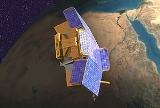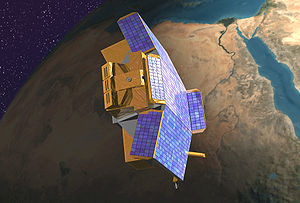
CHIPSat
Encyclopedia
 CHIPSat (courtesey NASA NASA The National Aeronautics and Space Administration is the agency of the United States government that is responsible for the nation's civilian space program and for aeronautics and aerospace research... ) |
|
| Organization | NASA NASA The National Aeronautics and Space Administration is the agency of the United States government that is responsible for the nation's civilian space program and for aeronautics and aerospace research... Space Sciences Laboratory Space Sciences Laboratory The Space Sciences Laboratory is an Organized Research Unit of the University of California, Berkeley. It is located in the Berkeley Hills above the university campus... , Berkeley University of California, Berkeley The University of California, Berkeley , is a teaching and research university established in 1868 and located in Berkeley, California, USA... |
|---|---|
| Contractor | SpaceDev, Inc. SpaceDev SpaceDev, a part of the "Space Systems Business" of Sierra Nevada Corporation, is prominent for its spaceflight and microsatellite work. It designed and built the hybrid rocket motors for Paul Allen's Tier One suborbital SpaceShipOne space program operated by Scaled Composites... |
| Mission Type | Astronomy Astronomy Astronomy is a natural science that deals with the study of celestial objects and phenomena that originate outside the atmosphere of Earth... |
| Satellite of | Earth Earth Earth is the third planet from the Sun, and the densest and fifth-largest of the eight planets in the Solar System. It is also the largest of the Solar System's four terrestrial planets... |
| Launch | January 12, 2003 on Delta II Delta II Delta II was an American space launch system, originally designed and built by McDonnell Douglas. Delta II is part of the Delta rocket family and was in service from 1989 until November 1, 2011... 7320-10 |
| Launch site | VAFB Vandenberg Air Force Base Vandenberg Air Force Base is a United States Air Force Base, located approximately northwest of Lompoc, California. It is under the jurisdiction of the 30th Space Wing, Air Force Space Command .... SLC-2W |
| Termination | April 11, 2008 |
| Nominal mission duration | 1 year |
| Mass Mass Mass can be defined as a quantitive measure of the resistance an object has to change in its velocity.In physics, mass commonly refers to any of the following three properties of matter, which have been shown experimentally to be equivalent:... |
64 kg (total), 40 kg (bus) |
| Webpage | chips.ssl.berkeley.edu |
| Orbital elements | |
| Semi-major axis Semi-major axis The major axis of an ellipse is its longest diameter, a line that runs through the centre and both foci, its ends being at the widest points of the shape... |
6955.88 km |
| Eccentricity Orbital eccentricity The orbital eccentricity of an astronomical body is the amount by which its orbit deviates from a perfect circle, where 0 is perfectly circular, and 1.0 is a parabola, and no longer a closed orbit... |
0.0013 |
| Inclination Inclination Inclination in general is the angle between a reference plane and another plane or axis of direction.-Orbits:The inclination is one of the six orbital parameters describing the shape and orientation of a celestial orbit... |
94.01 degrees |
| Orbital Period | 96.23 minutes |
| Right ascension Right ascension Right ascension is the astronomical term for one of the two coordinates of a point on the celestial sphere when using the equatorial coordinate system. The other coordinate is the declination.-Explanation:... of the ascending node |
11.86 degrees |
| Argument of perigee | 19.70 degrees |
| Instruments | |
| Spectrometer Spectrometer A spectrometer is an instrument used to measure properties of light over a specific portion of the electromagnetic spectrum, typically used in spectroscopic analysis to identify materials. The variable measured is most often the light's intensity but could also, for instance, be the polarization... |
A nebular spectrograph http://chips.ssl.berkeley.edu/instrument.html |
CHIPSat (Cosmic Hot Interstellar Plasma Spectrometer satellite) is a now-decommissioned, but still-orbiting, microsatellite
Miniaturized satellite
Miniaturized satellites or small satellites are artificial satellites of unusually low weights and small sizes, usually under . While all such satellites can be referred to as small satellites, different classifications are used to categorize them based on mass .One reason for miniaturizing...
. It was launched on January 12, 2003 from Vandenberg Air Force Base aboard a Delta II
Delta II
Delta II was an American space launch system, originally designed and built by McDonnell Douglas. Delta II is part of the Delta rocket family and was in service from 1989 until November 1, 2011...
with the larger ICESat
ICESat
ICESat , part of NASA's Earth Observing System, was a satellite mission for measuring ice sheet mass balance, cloud and aerosol heights, as well as land topography and vegetation characteristics...
, and had an intended mission duration of one year. CHIPSat was the first of NASA
NASA
The National Aeronautics and Space Administration is the agency of the United States government that is responsible for the nation's civilian space program and for aeronautics and aerospace research...
's University-Class Explorers (UNEX) mission (and is, as of 2011, still the only UNEX mission to date).
The primary science objective was to study the million-degree gas in the local interstellar medium
Interstellar medium
In astronomy, the interstellar medium is the matter that exists in the space between the star systems in a galaxy. This matter includes gas in ionic, atomic, and molecular form, dust, and cosmic rays. It fills interstellar space and blends smoothly into the surrounding intergalactic space...
. CHIPSat was designed to capture the first spectra of the faint, extreme ultraviolet glow that is expected to be emitted by the hot interstellar gas within about 300 light-years of the sun, a region often referred to as the Local Bubble. Surprisingly, these measurements produced a null result, with only very faint EUV emissions detected, despite theoretical expectations of much stronger emissions
It was the first U.S. mission to use TCP/IP for end-to-end satellite operations control.
The University of California, Berkeley
University of California, Berkeley
The University of California, Berkeley , is a teaching and research university established in 1868 and located in Berkeley, California, USA...
's Space Sciences Laboratory
Space Sciences Laboratory
The Space Sciences Laboratory is an Organized Research Unit of the University of California, Berkeley. It is located in the Berkeley Hills above the university campus...
served as CHIPSat's primary groundstation and manufactured the CHIPS spectrograph
Spectrograph
A spectrograph is an instrument that separates an incoming wave into a frequency spectrum. There are several kinds of machines referred to as spectrographs, depending on the precise nature of the waves...
, designed to perform all-sky spectroscopy
Spectroscopy
Spectroscopy is the study of the interaction between matter and radiated energy. Historically, spectroscopy originated through the study of visible light dispersed according to its wavelength, e.g., by a prism. Later the concept was expanded greatly to comprise any interaction with radiative...
. Other ground network support was provided by groundstations at Wallops Island, Virginia and Adelaide, Australia. CHIPSat's spacecraft platform was manufactured by SpaceDev
SpaceDev
SpaceDev, a part of the "Space Systems Business" of Sierra Nevada Corporation, is prominent for its spaceflight and microsatellite work. It designed and built the hybrid rocket motors for Paul Allen's Tier One suborbital SpaceShipOne space program operated by Scaled Composites...
.
In January 2007 the spacecraft was converted to a solar observatory. Satellite operations were terminated in April 2008.
External links
- "Good-bye Mr. CHIPS", Chris Thompson, East Bay Express, 2 July 2008.

